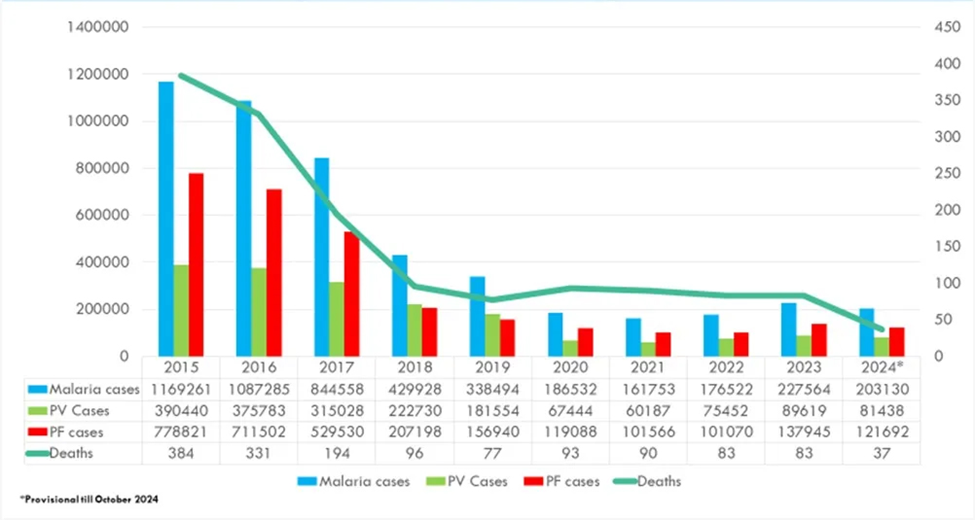India has made monumental progress in its fight against malaria, achieving significant reductions in cases and deaths. Once plagued by an alarming malaria burden, the country now stands as a global example of public health transformation. According to the World Health Organization's (WHO) World Malaria Report 2024, India has successfully reduced malaria-related cases by over 97% since its independence. This milestone is the result of targeted efforts, policy innovations, and widespread community involvement. India is now firmly on the path to becoming malaria-free by 2030, aligning with global health goals.
Key Milestones in Malaria Control:
1. Dramatic Reduction in Cases and Deaths
India’s malaria control journey began with a staggering burden:
- Historical Context: In 1947, India reported 75 million malaria cases and 800,000 deaths annually. This was a critical public health issue that required immediate intervention.
- Progress by 2023: By 2023, annual malaria cases had plummeted to 2 million, and malaria-related deaths were reduced to just 83, signifying:
- A 97% decrease in cases.
- A 99.99% reduction in deaths, an extraordinary achievement in global malaria control.
Key Data from 2015 to 2023:
- Malaria cases decreased from 11.7 lakh in 2015 to 2.27 lakh in 2023.
- Malaria-related deaths dropped from 384 (2015) to 83 (2023).
- Annual Blood Examination Rate (ABER), a crucial indicator for early detection, improved from 9.58 (2015) to 11.62 (2023), reflecting enhanced surveillance.
2. India’s Exclusion from WHO’s High Burden to High Impact Group
India’s exclusion from the WHO’s High Burden to High Impact (HBHI) group in 2024 is a landmark achievement. The HBHI initiative identifies countries with the highest malaria burden, and India’s removal highlights the success of its strategic measures.
3. State-Wise Progress in Malaria Burden (2015–2023)
India’s malaria burden has significantly decreased at the state level:
- 2015: Ten states and Union Territories (UTs) were classified as high-burden Category 3 regions.
- 2023: Only Mizoram and Tripura remained in this category. Key improvements include:
- States like Odisha, Chhattisgarh, Jharkhand, and Meghalaya transitioned to Category 2.
- 24 states and UTs moved to Category 1, reporting an Annual Parasite Incidence (API) of less than 1 case per 1,000 population.
- Category 0 States: Ladakh, Lakshadweep, and Puducherry achieved zero indigenous malaria cases, qualifying for subnational verification of malaria elimination.
Strategic Frameworks for Malaria Elimination:
India’s success in malaria elimination is underpinned by robust frameworks and focused policies.
1. National Framework for Malaria Elimination (NFME) (2016)
Launched with the objective of eliminating indigenous malaria cases by 2027, NFME focuses on:
- Strengthening surveillance systems for early case detection.
- Ensuring prompt treatment to reduce transmission.
- Implementing vector control measures, such as Indoor Residual Spraying (IRS).
2. National Strategic Plan for Malaria Elimination (2023–2027)
This strategic plan emphasizes modern technology and rapid response:
- Deployment of real-time data tracking through the Integrated Health Information Platform (IHIP).
- Adoption of a “Testing, Treating, and Tracking” (3T) approach for early detection, case management, and prevention of outbreaks.
3. Integrated Vector Management (IVM)
Vector control remains a cornerstone of malaria elimination:
- Use of Indoor Residual Spraying (IRS) and distribution of Long-Lasting Insecticidal Nets (LLINs) to control mosquito populations.
- Special attention to managing Anopheles stephensi, a significant vector in urban malaria.
Strengthened Surveillance and Diagnostic Capacities:
India has significantly enhanced its capacity to detect, diagnose, and respond to malaria cases:
- National Reference Laboratories (NRLs) at the National Centre of Vector Borne Diseases Control (NCVBDC) ensure the accuracy and reliability of diagnostics.
- Localized action plans address region-specific challenges, particularly in tribal and forested regions where malaria prevalence is higher.

Community Engagement and Capacity Building:
Community participation is a cornerstone of India’s malaria elimination strategy:
- Ayushman Bharat Health Packages: These integrate malaria prevention and treatment services into broader healthcare delivery, ensuring access for vulnerable populations.
- Grassroots Engagement: Community Health Officers (CHOs) and Ayushman Arogya Mandirs provide malaria services at the community level.
- Training and Capacity Building: In 2024, over 850 health professionals received training through National Refresher Programs, boosting their ability to manage and prevent malaria effectively.
Collaborations and Funding Mechanisms:
1. Intensified Malaria Elimination Project-3 (IMEP-3)
The IMEP-3 initiative targets 159 districts across 12 states, focusing on vulnerable and high-risk populations.
2. Resource Allocation
- Distribution of LLINs to prevent malaria in high-risk areas.
- Funding for entomological studies to monitor mosquito behavior and resistance patterns.
- Strengthening surveillance systems to detect and manage outbreaks effectively.
Future Challenges and Solutions:
Challenges
- Urban Malaria: The rise of urban malaria due to Anopheles stephensi, an urban vector, poses unique challenges.
- Remote Areas: Tribal and forested regions remain hotspots for malaria transmission.
- Climate Change: Rising temperatures and changing rainfall patterns may alter mosquito breeding cycles.
Proposed Solutions
- Enhanced Urban Surveillance: Strengthening vector management in urban centers.
- Focused Tribal Interventions: Deploying mobile health teams in remote areas.
- Climate-Resilient Strategies: Adapting malaria control methods to mitigate the effects of climate change.
Future Outlook: Commitment to a Malaria-Free India by 2030:
India aims to achieve zero indigenous malaria cases by 2027, with a complete malaria-free status by 2030. The following strategies are central to this vision:
- Strengthened Surveillance: Expanding real-time monitoring and reporting systems.
- Comprehensive Community Engagement: Increasing grassroots awareness and participation.
- Innovative Technologies: Leveraging AI and GIS mapping for better vector control and outbreak prediction.
Conclusion:
India’s remarkable progress in malaria control is a testament to its integrated public health approach. The country’s journey—from being one of the most malaria-endemic nations to nearing malaria-free status—illustrates the power of political commitment, community participation, and scientific innovation. As India marches toward its 2030 goal, its achievements serve as a model for other malaria-endemic nations, reaffirming the importance of targeted, sustainable, and inclusive health strategies.
|
Probable questions for UPSC Mains exam: Examine the role of targeted government interventions and community participation in addressing public health challenges in India. Use recent health achievements as examples. |







